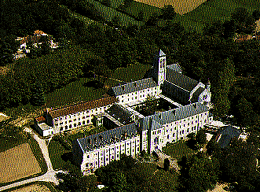
![]()
81110 Dourgne,
Tarn, France
Tel: (33) 5 63 50 32 37
Benedictines, Subiaco Congregation
(Founded in 1890)
|
|
|
|

|

|

Fr. Urbain Seres, OSB (ca 1947) |
Fr. Marie de Floris, OSB Abbot 1943-1953
Abp. Gabriel-Marie Garrone
|
|
Several circumstances converged to bring the Benedictines of En Calcat into the world of "short breviaries". First, there was Pius XII's Encyclical, Mediator Dei of 1947, in which he encouraged greater participation of active (teaching, hospital, etc.) communities of Sisters and Brothers, as well as lay people, in the liturgical life of the Church, including the Divine Office. The Encyclical was, in so many ways, an approval by Rome of the liturgical movement (begun in the previous century by Prosper Gueranger, OSB, of Solesmes, but made a pastoral movement by Lambert Beauduin, OSB, at the Malines Conference in 1909) throughout the Catholic world.
After several meetings which included
the monks, Archbishop Garrone
(who translated the psalms in French),
Canon Rene Desjardins (who was responsible for the hymns), the Abbe
Viale (who decided on the final lectionary), and others in 1948,
the Abbot, Fr. Marie de Floris, decided to use some of the funds from the
legacy for the project of preparing a new office and provided all the monks
an opportunity to become actively involved in the liturgical movement.
The team would meet, study, share ideas,
then develop and publish, with the Abbey as publisher, a new office.
By 1950, a typed manuscript was more or less ready.
|
 |
Guiding Principles
|
| After the 2nd Vatican Council, when the Consilium (the Vatican agency responsible for new liturgical texts mandated by the Council reforms) prepared the new Liturgia Horarum (first edition, 1972), it used many of the same principles of Livre d'Heures. |
|
Livre d'Heures
|
Fr. Dominique Hermant, OSB, today
|
From left to right: Fr. Louis Arnal, OSB, monk of En Calcat,
and at the time of this photo (1959), Procurator General
for the Subiaco Congregation of Benedictines,
Pope John XXIII,
Fr. German Barbier, OSB, Abbot of En Calcat (1953-1965),
and Fr. Dominique Hermant, OSB, who had primary responsibility for the
preparation and publication of the various editions of The Office of Our Lady,
and who was Abbot from 1965 to 1978.
Pope John, when he was Papal Nuncio to France (1944-1953) had made a private retreat at En Calcat. Fr. Barbier, then prior, was his retreat Master.
The occasion for this photo was the Abbey's presentation of a copy
of The Office of Our Lady to the Holy Father during a private audience (ca. 1959).
|
Return to Home Page |
Go to "Introduction" Page |
|
|
|
|
|
|
|
|
|
|
En Calcat's Own Home Page |
|